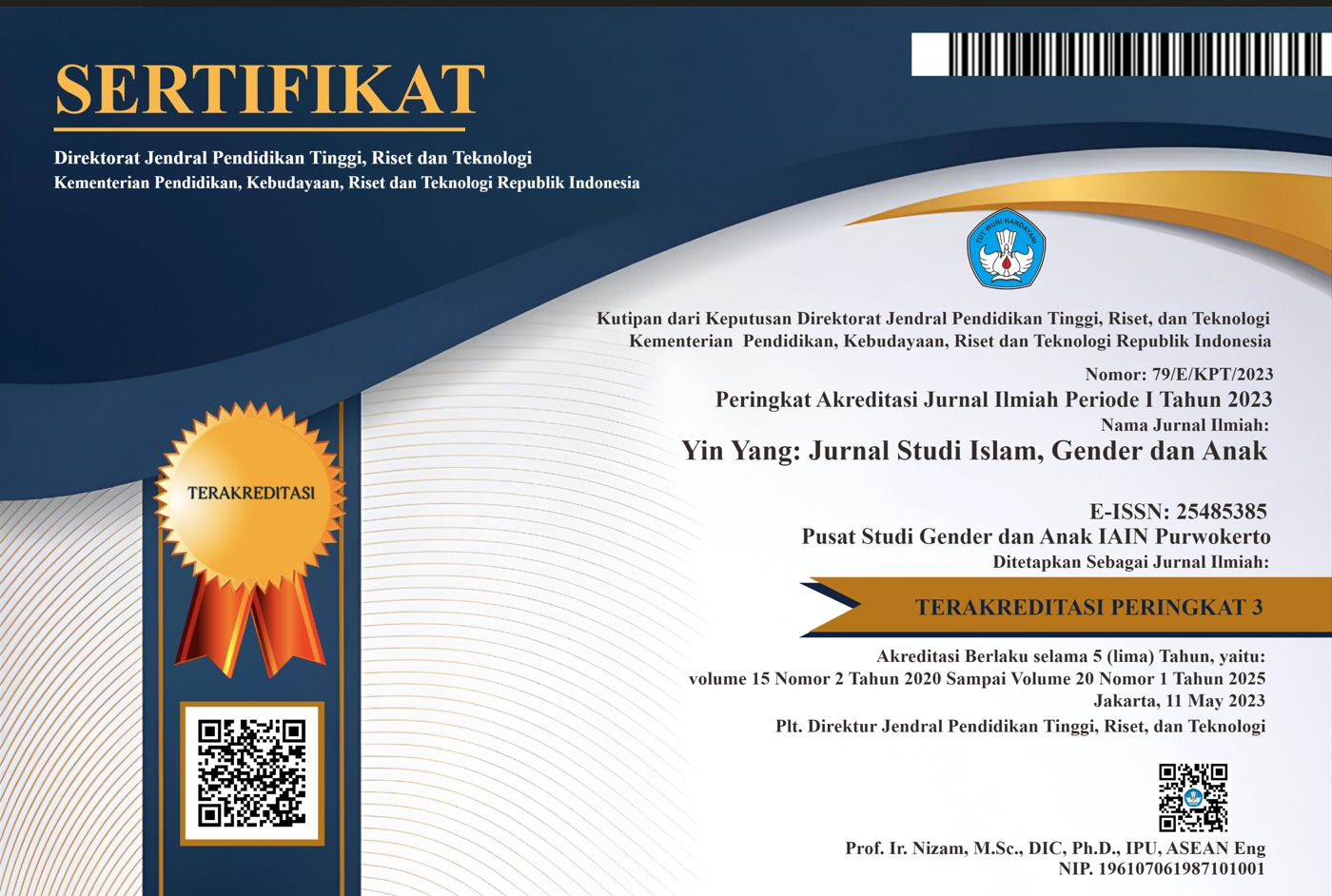The determinant factor of juvenile delinquency (path analysis model)
DOI:
https://doi.org/10.24090/yinyang.v19i2.12083Keywords:
determinants, juvenile delinquency, path analysis modelAbstract
There are many determinants of juvenile delinquency, one of them is technology. Technology is an integral part of modern society. However, misuse and uncontrolled use of technology may lead to negative impacts, one of which is juvenile delinquency. The objective of the study was to develop a determinant model of juvenile delinquency elicited from a path analysis. It was an observational study with a cross-sectional design. The sample size was 295 adolescents aged 12-19 years, consisting of adolescents at school and in the Juvenile Detention Centre (JDC). The data were taken a simple random sampling technique.. The analysis used Structural Equation Modelling. The determinants, which had a direct influence on juvenile delinquency were technology, peers, and lifestyle. Technology played a central role as the determinant that directly affected juvenile delinquency as many as 2.03 (203%). Digital technology may threaten adolescents as it can create and increase their delinquent behavior if its use is not controlled. The use of technology by adolescents needs to be supervised by parents and teachers together with nurses in community-based health practice.Downloads
References
Anjaswarni, Tri., Nursalam. Nursalam, Sri. Widati, Ah. Yusuf, and Rr.D. Tristiana. 2019. “Development of a Self-Efficacy Model in Junior and Senior High School Students Based on Religiosity and Family Determinants: A Cross Sectional Approach.” International Journal of Adolescent Medicine and Health, 1–8. https://doi.org/10.1515/ijamh-2019-0023.
Anjaswarni, Tri, Nursalam, Sri Widati, and Ah Yusuf. 2020. “Analysis of Risk Factors Occurrence of Juvenile Delinquency Behavior.” Indian Journal of Public Health Research & Development 11 (2): 1924–28. https://doi.org/10.37506/v11/i2/2020/ijphrd/195111.
Azhar, Rajman. 2019. “70 Persen Anak Kecanduan Gadget.” Bengkuluekspress.Com, 18 Desember 2019. Bengkulu. 2019.
Baqutayan, Shadiya Mohamed Saleh. 2015. “Stress and Coping Mechanisms : A Historical Overview.” Mediterranean Journal of Social Sciences 6 (2): 479–88. https://doi.org/10.5901/mjss.2015.v6n2s1p479.
Calhoun, Georgia B, Brian A Glaser, and Christi L Bartolomucci. 2011. “The Juvenile Counseling and Assessment Model and Program: A Conceptualization and Intervention for Juvenile Delinquency.” Journal Of Counseling & Development 79: 131–41. https://doi.org/https://doi.org/10.1002/j.1556-6676.2001.tb01952.x.
DeLisi, Matt, Michael G Vaughn, Douglas A Gentile, Craig A Anderson, and Jeffrey J Shook. 2012. “Violent Video Games , Delinquency , and Youth Violence : New Evidence.” Sage: Youth Violence and Juvenile Justice 11 (2): 132–42. https://doi.org/10.1177/1541204012460874.
Howell, James C. (Buddy), Mark W. Lipsey, John J. Wilson, and Megan Q. Howell. 2014. “A Practical Approach to Evidence -Based Juvenile Justice System.” Journal of Applied Juvenile Justice Services, 1–21.
Kementerian Komunikasi dan Informatika Republik Indonesia. 2018. “Kecanduan Gawai Ancam Anak-Anak.” Sorotan Media, 23 Juli 2018. Jakarta. 2018.
Kenny, Dianna T, Susan Blacker, and Mark Allerton. 2014. “Reculer Pour Mieux Sauter: A Review of Attachment and Other Developmental Processes Inherent in Identified Risk Factors for J Juvenile Delinquency and Juvenile Offending.” Laws 3: 439–68. https://doi.org/10.3390/laws3030439.
McCuddy, Timothy. 2018. “Online Socialization and Delinquency: Expanding the Study of Peer Influence in Criminology.” University of Memphis.
Nursalam. 2015. Metodologi Penelitian Ilmu Keperawatan. Edisi 4. Jakarta: Salemba Medika Jakarta.
Pathak, Kanisha V. 2017. “Juvenile Delinquency : Role of Mass Media.” International Journal of Academic Research and Development 2 (6): 279–82.
Radar Bogor. 2017. “85 Persen Pelajar ” Kecanduan ” Gadget.” Radar Bogor, 24 Nopember 2017. Bogor. 2017.
Rokven, Josja J., Gijs Weijters, Marinus G.C.J. Beerthuizen, and André M. van der Laan. 2018. “Juvenile Delinquency in the Virtual World: Similarities and Differences between Cyber- Enabled, Cyber-Dependent and Offline Delinquents in the Netherlands.” International Journal of Cyber Criminology 12 (1): 27–46. https://doi.org/10.5281/zenodo.1467690.
Srivastava, Astha, and Shivangi Sinha. 2019. “Cyber Delinquency: Issues and Challenges under Indian Legal System.” International Journal of Engineering and Advanced Technology 8 (5 C): 1426–28. https://doi.org/10.35940/ijeat.E1204.0585C19.
Stalans, Loretta J., and Mary A. Finn. 2016. “Understanding How the Internet Facilitates Crime and Deviance.” Victims and Offenders 11 (4): 501–8. https://doi.org/10.1080/15564886.2016.1211404.
Wijanto, Setyo Hari. 2008. Structural Equation Modeling Dengan Lisrel 8.8: Konsep & Tutorial. Pertama. Yogyakarta: Graha Ilmu, Yogyakarta.
Zaini, Muhammad, and Soenarto Soenarto. 2019. “Persepsi Orangtua Terhadap Hadirnya Era Teknologi Digital Di Kalangan Anak Usia Dini.” Jurnal Obsesi : Jurnal Pendidikan Anak Usia Dini 3 (1): 254–64. https://doi.org/10.31004/obsesi.v3i1.127.
Downloads
Published
How to Cite
Issue
Section
License
Copyright (c) 2025 Tri Anjaswarni

This work is licensed under a Creative Commons Attribution-ShareAlike 4.0 International License.
Authors who publish with this journal agree to the following terms: Authors retain copyright and grant the journal right of first publication with the work simultaneously licensed under a Creative Commons Attribution-ShareAlike 4.0 International License that allows others to share the work with an acknowledgment of the work's authorship and initial publication in this journal.
















